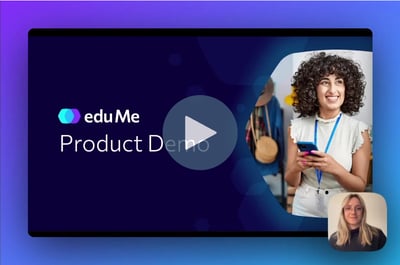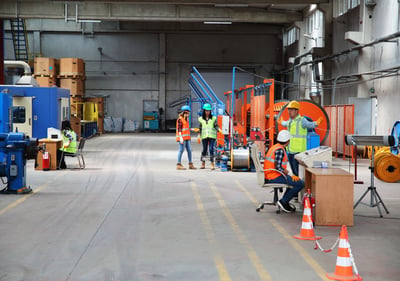Where and how we work is changing rapidly. This is mainly driven by three seismic changes coming together at the same time:
-
50% of the global workforce will be mobile by 2020;
-
75% of the workforce will be made up of millennials by 2025;
-
The way we consume information and communicate has fundamentally changed with the advent of the smartphone.
How does this impact how companies motivate and engage their workforce and what does the future of workforce learning look like?
The mobile workforce
Where we work is changing - fast. Soon, 50% of the global workforce will be mobile or partly mobile or remote.
The Economist published a really funny (yes, really) and thought-provoking article a while ago about the rise of the gig economy and what it would be like if there were no jobs anymore.
The general gist was that jobs at McDonalds would be 100% outsourced - you have to bid for them on TaskRabbit! The media headline would then be: “The First Fortune 500 Company With No Employees”.
Whilst this is a tongue in cheek suggestion, it's an uncontested fact that a rapidly growing number of the workforce no longer fit under the traditional employee label.
McKinsey released a report a couple of years ago, which found that more than 160 million people in Europe and the United States — equivalent to 20-30 per cent of the working-age population— were engaged in some form of independent work.
Points for reflection:
-
Do you work from the office every day? What about your family and friends; do they work from an office all the time?
-
How many people have you met over the last couple of days that were not “traditional” employees?
-
Do you use freelancers or contractors at work?
-
When was the last time you took an Uber or ordered food via Deliveroo or Postmates?
Do you think this changing nature of the workforce is reflected in the public debate? What industries are most discussed, gets most headlines, most sympathy, strongest opinions, most political attention and interference?
For example, did you know that the US coal industry employs 80,000 workers and US Steel employs 150,000 people?
In the UK there’s a lot of talk about the car manufacturing business in connection to the brexit debate. Car manufacturing in the UK employs 180,000 people.
Similarly the demise of the high street has been proclaimed for some time now and certainly there’s an abundance of retailers closing but it does still employ a staggering 2,9 million people.
But contrast this with the number of people working in the gig economy, which is estimated at 5 million in the UK! That's more than 15 per cent of the total full and part-time workforce. Imagine - one in six jobs in the UK are in the gig economy!
Millennials entering the workforce
Now to the second big change.
The demographic of the workforce is being turned upside down. 75% of the global workforce will be made up of millennials (people born 1981 and later) in just a few years and not only do they think and appreciate other things, they have grown up doing things differently.
This generation values learning and development very highly - in fact, it’s one of their top priorities when choosing where to work and whether to stay!
43% of millennials expect to leave their jobs within 2 years and according to Deloitte, 73% of young professionals who plan to stay with their employers for more than 5 years say their organisations are strong providers of education and training. This is because the role of employer as educator continues to take on significance and can’t be ignored.
Among those millennials who would willingly leave their employers within the next two years, 62% regard the gig economy as a viable alternative to full-time employment. Why? The promise of a higher income, with increased flexibility and freedom.
Moreover, 81% of millennials state that self-paced learning will be important to help them perform their best.
The smartphone revolution
Which brings us to the third point. The way we consume information and communicate has radically changed with the advent of the smartphone.
Mobile is the fastest growing technology in human history. There are 2.7 bn smartphone users in the world and they outnumber PCs 2.5x.
We check our phones every 12 minutes. And that’s based on the average adult use, which is less than millennials!
Two in five adults (40%) first look at their phone within five minutes of waking up, rising to 65% of those aged under 35, while 37% of adults check their phones five minutes before lights out, again rising to 60% of under-35s.
Points for reflection:
Now, if you think this sounds a bit insane just check open your iPhone and check your Screen Time. This will show you in no uncertain terms what YOUR screen habits are actually like.
-
How often do you pick up your phone during the day?
-
How many hours per day do you spend?
-
What are your most used apps and what categories do they fall into?
-
Do you spend an inordinate amount of time on social media? More than you feel comfortable with?
Summarising the current environment
So, we’ve established that jobs are shifting into non-traditional industries. To positions that are not desk-based. We’ve got a shorter attention spans but more information to take in. Deloitte research shows that employees take less than 25 minutes of time to actually slow down and learn on a weekly basis.
The people working are also different with new priorities and ways of doing things. What does all this mean for learning and development?
The future of workplace learning
After everything we’ve concluded so far, does it make sense to say: “yeah, let’s schedule that next training session now and get everyone into the office for 1-2 days of training?
Let’s fire up the ol’ desktop computers and put all our staff in front of this eLearning module where they click through to the next screen with their mouse, you watch a 40 min long video and that’s the end of it.
Does this sound engaging to you? Sustainable? Scalable?
So what does the future of learning look like?
We believe that you have to provide learning opportunities at the point of need. Josh Bersin, the world’s most influential HR analyst calls this “Learning in the flow of work”.
Can you relate to that expression?
He made this thesis where he generously mentioned eduMe as on of a new breed of learning platforms that are relevant for the modern workforce.
Research shows that short-form content results in 20% higher information retention. AND it fits into busy schedules with lots of starts/stops. The average completion rate at eduMe f.ex. is 95%.
At eduMe, we’re working with the trailblazers of the new economy like Uber - a case in point of delivering training at the point of need.
More traditional companies are now also waking up to this fact and the pyramid of where training is being carried out will be inverted in the next 5-10 years where at-the-point-of-need is the new normal.
Learning done right in this new context will help you you motivate and engage your workforce. You’ll be able to build a sense of community and build your culture. This will breed loyalty and productivity. This is not a nice to have. You need to have solid learning strategy to succeed in today’s world!







